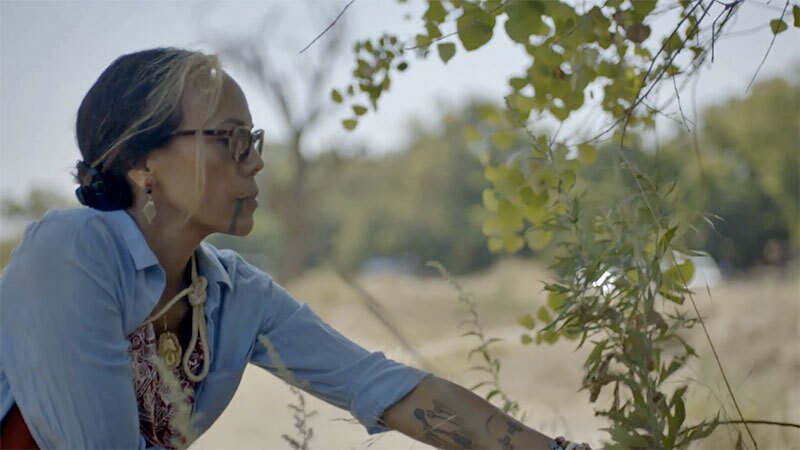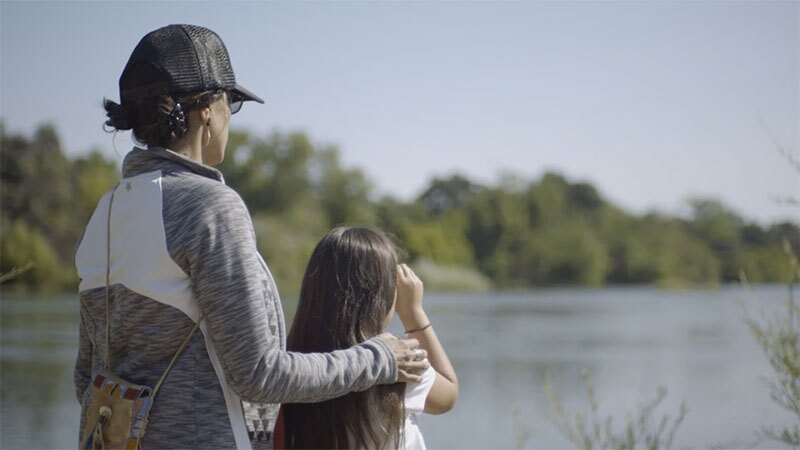Sage Lapena | Photo: KCET
Tune in to KCET TV on February 7th at 9pm to watch the documentary “Tending The Wild.”
Sage Lapena is a Nomtipom Wintu ethnobotanist and certified herbalist. She has worked for many years to preserve and communicate Indigenous uses of plant medicines from both native and exotic plants, as well as other traditional ecological knowledge related to plants. We spoke with her in Folsom, California.
What is Traditional Ecological Knowledge?
Traditional Ecological Knowledge (TEK) is a body of science that encompasses all science, but has only recently been recognized as a true science. People who have lived in the same place, in the same region for 1000 years have observed all of this together: the changing of the seasons, the migration of animals, birds, insects, the changes in the celestial bodies, the fire patterns and how they affect the plants. Hunting, fishing, gathering plants, means of survival, observing the science of the stars, etc. All of this is included in TEK.
How long have indigenous people been farming this land?
When the Spanish were exploring in the 1500s and 1600s, they wrote in their journals that this was the Garden of Eden. They discovered it because people used the land. We created abundance by using the plants that explorers saw when they came to new lands. Used by humans, humans become part of a web, a chain, responsible for cultivating it, burning it. Some people think of the three Rs as “reading, writing, arithmetic,” but they are “responsibility, respect, mutual respect.” We take so much from the Earth, but we give nothing back.
How did you find out about plant medicines?
Herbalism is not just, “Here are herbs, go ahead and take some.” The way I trained to be an herbalist was to actually go sit in the woods with my mentor, Mabel McKay. She asked me to sit in the woods for a period of time and just observe and be aware. I learned a whole different understanding of herbalism; it's not about how herbs affect individual body systems, it's about nature as a whole.
More from Tending The Wild
Mabel was well known as a basket weaver and as a physician. She was Pomo and Winton. She would take me to various places in Northern California where she would congregate, sometimes for basketry, sometimes for other medicines, and would talk to me about what I was seeing. Other times she would let me sit alone in the woods and observe and participate in what I was witnessing. It wasn't really something that was given to me like, “I'm going to learn about this.” It just happened in a more organic way.
It wasn't until I was in my twenties, working at a nursery in Sonoma County, meeting Essie Parrish's daughter, and working with her and the others I spoke with, that I learned that I was training as a herbalist, to be a physician or pharmacist for my tribe. I studied what is considered traditional Native American herbalism.
How did you become a certified herbalist?
As a practitioner of traditional Native American medicine, there is no certifying body. However, I went back to school to become a certified medical herbalist. [at the American Herbalist Guild]I was using the knowledge I already had and conducting workshops and teaching from my own knowledge base.
I went back to college and studied physiology and standardization of extracts. Then I had to get into clinical work. I worked with a doctor in an herbal pharmacy at the Sonoma County Indian Health Service in Santa Rosa. After spending a lot of time there and also working at the California School of Herbal Studies clinic, I got certified. I knew how to write prescriptions.
As an herbalist, how do you source the plant-based medicines you use?
You need to know where you're getting your herbs from, what time of year you're harvesting them, when you're spraying them, and if they're on other people's land on a regular basis. You may be able to get a harvesting permit from the state of California, or you may have a memorandum of understanding with a private landowner if you're harvesting certain herbs. There's a lot to think about when it comes to participating in your culture and participating as a traditional person working with the herbs on your land. My activity, even just as a herbalist, is to go out and try to harvest every day.

Sage Lapena gathers mugwort. Photo: KCET
When you go to a sacred place, whether it is marked on a map or not, it is still a sacred place. You get something from the place by being close to it and being a part of it. I have been to places where I could have harvested medicines, but I left without harvesting any plant material. Instead, all that is harvested in some places is knowledge, in the sense of oneness. You go back to harvest the energy again. The human body is a huge electromagnetic field. We have all those elements. The electricity that is in your fibers, the soil, the water, the air, everything that flows through our being. When we are away from the land, we need to recharge. That's why many of our sacred places are places where there is moving water. Moving water is negative ions. Waterfalls, coastlines are all places where you can recharge, and we are drawn to these places, even ordinary people who don't necessarily know that something is a sacred place.
Can you give examples of how you use certain plants?
About Native Americans
Artemisia is one of the plants that is often used in women's medicine. When made into a tea, it helps regulate the menstrual cycle and menstrual cycle. The main component of the oil that is found in Artemisia has a very bitter nature. This bitter action helps to balance all the systems. When you ingest something that is bitter, your digestive system works better because your gallbladder and pancreas communicate with each other. They work in harmony. Tonics have to do with tonicity, so when you tonic these walls, it tones that through both the blood and digestion through the cell walls, which then goes into the blood system and actually goes through the intestinal walls and helps to tonic the whole body. When your strength is tonic, you don't cramp as much. When you're tonic, all the smooth muscles work together.
There is [also] There are herbs that help balance the body. One of them is vitex. There are also leaves that are beneficial for the body, such as raspberry leaves. There are also tonic and nutritive properties. [plants and herbs that] Rebalance your own particular system. Everybody is different, everybody has different needs. We eat different foods, we live different lifestyles, but if you have a reproductive system, whether you're male or female, you can use these herbs tonic.
You have worked as an herbalist caring for cancer patients.
In fact, when I saw cancer patients, I worked with three oncologists, two of whom said they would typically prescribe chemotherapy and radiation, but they would probably want to go the route of looking for herbs, because deep down they knew that wasn't the right approach because it has such widespread effects throughout the body.
I think the reason so many people choose radiation or chemotherapy is because they wait too long to seek treatment for their cancer in the first place. They're in denial and they don't allow their intuitive body to tell them something is wrong. Then the system goes haywire and it becomes very hard to substitute radiation or chemotherapy with anything other than herbs, nutrition, or chemical warfare. It's a last resort when you're really looking for help. People who look at cancer in general, like oncologists, know that if people sought help sooner, they would likely benefit from using herbs to treat their cancer.
What do you want people to know about Indigenous people?
When I teach classes, I really want people to understand that as Native Californians, as traditional people, we use the same medicines that they do, and that we traditionally harvest these medicines on our own land or on public lands within tribal territory. After people learn about herbs and know how great they are, they go out and collect all the herbs, and we don't have access to them.
It is really important for people to understand that we are not an extinct people. And that our villages are [were built] It's right under the shopping malls and the city parks. We still find artifacts of the indigenous people who lived here for thousands of years. Their footprints are still here. I think it's important for young people and older people who don't necessarily visit these places to go back to these places and have a sense of belonging to where their ancestors came from, where the DNA that runs through their bodies comes from. Because we are part of the environment, and when we feel ungrounded or we live in a high rise or we live far away from the land, it's important to go back to the place and feel one with the place.

Passing knowledge across generations: Lapena and her daughter on the American River. Photo: KCET
How do you hope Americans will interact with plants in the future?
We've been trained for generations, especially in this country, to react to our environment in a certain way or not at all. We can do better — to be more conscious about what we do on a daily basis. So many of our medications, including those to keep us and ourselves in balance, are just there for us to take advantage of.
What I would like to see in the future is a lot more civil disobedience in terms of putting Monsanto to death. After all, this is a global genocide. Corporations and businesses led by a few unhealthy, scared and ignorant people have a very shortsighted view of what's important. And more people saving seeds, understanding the environment, getting out and understanding what it is before it's gone, getting involved, learning what they're missing out on. When you understand something better, you care more about protecting it.

A collaboration between KCETLink and the Autry Museum of the American West, the “Tending the Wild” series will be exhibited in conjunction with the Autry Museum's groundbreaking “California Continued” exhibition.


